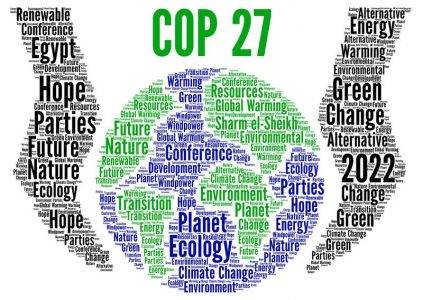AFTER ALL, WHAT’S LEFT OF COP27?
The 27th session of the United Nations Climate Conference – also known as the COP or the UN Conference of Parties – was organized and hosted in November 2022 by Egypt in Sharm El Sheikh. As in all its editions, the COP is an opportunity for the global community to catalyze much-needed progress in climate action and trigger plans for slowing global warming. It happens through intense diplomatic negotiations between nearly 200 countries.
As an annual event since 1995, the COP emerged when the United Nations Framework Convention on Climate Change (UNFCCC) established an international environmental treaty to combat threatening human intervention in ecosystems.
After two weeks of several negotiations, including a possible indication of abandonment of the European Union a few hours before the meeting ended, COP27 closed with a delay of two days. The results were presented in two main documents – a final statement and a resolution on compensation for the damage caused by climate change suffered by vulnerable countries.
Among the good news, representatives from almost 200 countries reached some consensus, outdoing the results of 2021’s COP26 in Glasgow, Scotland, which was unable to ensure the goal of limiting global warming to 1,5 C. The world has warmed by 1,1 C since the mid-19th century.
Below, you will find five significant COP27 findings that should be on the agenda and our radar until the next edition:
FINDING # 1 – It was one of the most crucial COPs ever since we had as an agenda not only the climate crisis but also the conflicts, the economic crisis, COVID-19, the loss of biodiversity, and an extremely complex scenario.
FINDING # 2 – Finally, there was a consensus on creating a global fund to pay for losses and damages. The agreement recognizes that the wealthiest nations, the most significant historical issuers of greenhouse gases, are responsible for the damage caused by rising temperatures. But, despite decades after this discussion demanded by the poorest countries and avoided by the rich countries, the fund still does not bring elementary definitions about who will provide resources, how much aid is at stake, and which countries will receive them.
FINDING # 3 – COP 27 was an opportunity to highlight Africa’s leadership in combating climate change and its vision for a fair and sustainable future without leaving anyone behind. According to William Ruto, president of Kenya, “Africa contributes less than 3% of climate change pollution but was most severely affected by the ensuing crisis.”
FINDING # 4 – It is already known, through so much scientific evidence, that climate impacts also influence gender equality. According to UN Women (2022), women and girls face more significant obstacles to climate adaptation, disproportionate economic repercussions, increased unpaid care and domestic work, and increased risk of violence due to the aggravating impacts of the crisis. At COP27, few women were participating in the negotiations on climate change – women represented less than 34% of the delegations from the countries that participated in the UN climate conference. Without a more expressive female representation in the discussions, the problem may not be indeed solved.
FINDING # 5 – On Brazil’s participation: president Jair Bolsonaro did not attend the conference and was not in the previous edition of the event. However, the delegation sent and paid by the government to Egypt was the second largest of the conference, with about 570 people. Among them, the low presence of researchers and the lack of environmental NGOs, indigenous organizations, and social movements in the official delegation were noted.
Regarding Brazil’s commitment to COP27, the country has not raised the ambition of its goals, entering the list of countries stagnant in climate action. Its NDC (Nationally Determined Contribution, the voluntary goals and commitments undertaken by each government within the Paris Agreement), submitted in March 2022, is especially committed to reducing GGE by 37% in 2025 and 50% in 2030 compared to 2005 emissions, aiming to achieve carbon neutrality by 2050.
However, the increase in GGE even during the Covid-19 pandemic, and the constant increase in deforestation reinforce the perception of setbacks in this fight. In addition, according to Climate Action Tracker, the commitments made are below what is necessary to achieve the target of 1,5°C. They do not correspond with the proportion of emission reduction under Brazil’s responsibility.
NATALIA DE CAMPOS TAMURA
Ph.D. in Communication Sciences from USP, Master in Education, Art and History of Culture, Specialist in Communication Management. Bachelor of Public Relations. Researcher and professor of the Public Relations course at Faculdade Casper Libero College and the Aberje MBA course.
COMENTÁRIOS:
Destaques
- Sports as an instrument of Change
- Aberje Launches Newsletter with Economic Panorama
- Charting a Path to Responsible Communication: WPRF 2023 Wraps Up in Chennai, India
- Global Alliance AGM elects new Board 2023
- Aberje discloses its positions on the Fake News Bill (PL 2630/2020)
ARTIGOS E COLUNAS
Paulo Nassar Fala na abertura do Seminário Opinião Pública, Política e DemocraciaRegina Macedo Narrativas femininas: amplitude e diversidade na comunicaçãoPatricia Santana de Oliveira Qual retorno do investimento em PR?Marcos Santos Esporte como Plataforma de MarcaCarlos Parente Na vida e no mundo corporativo, não há texto sem contexto



























